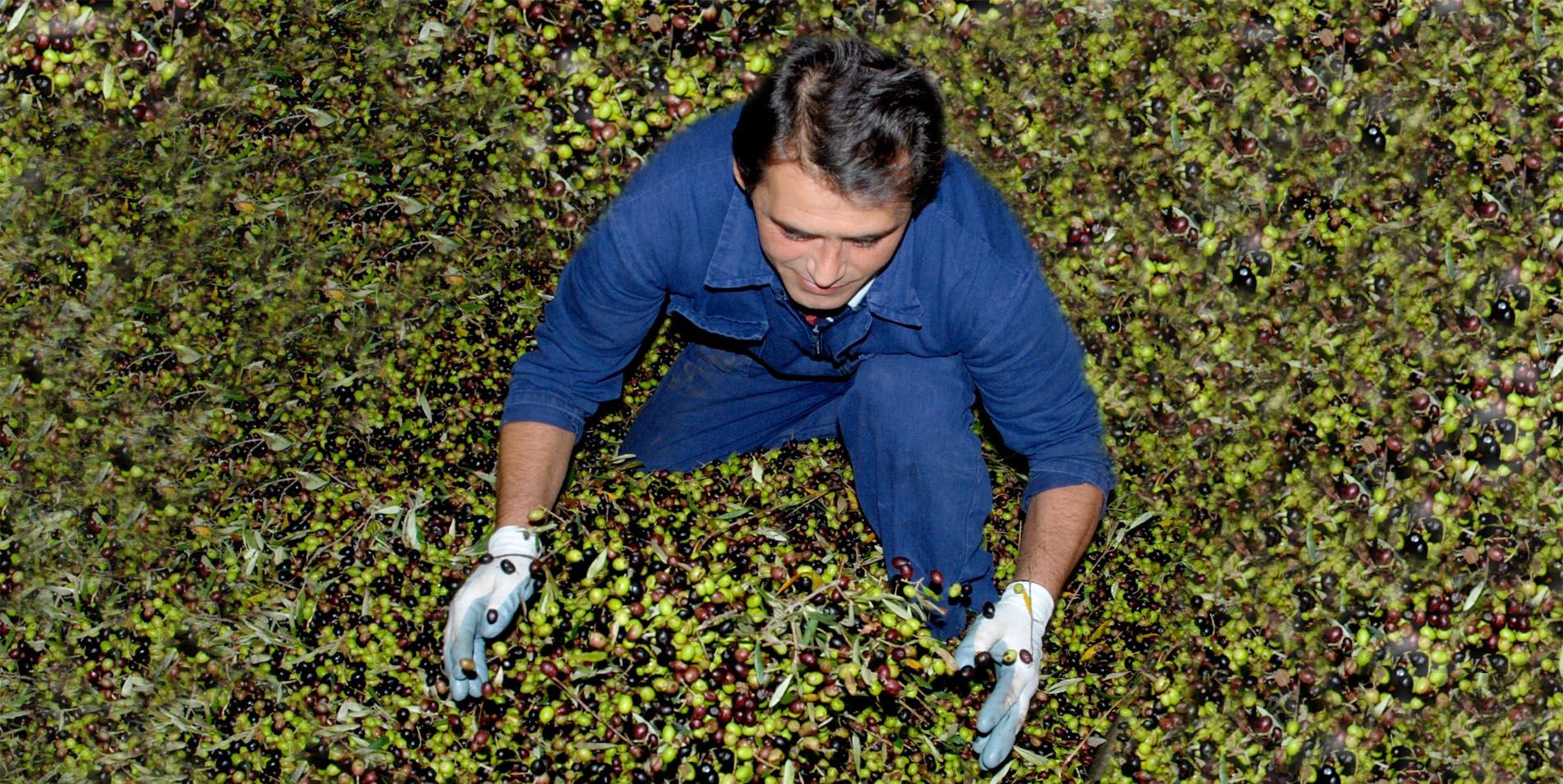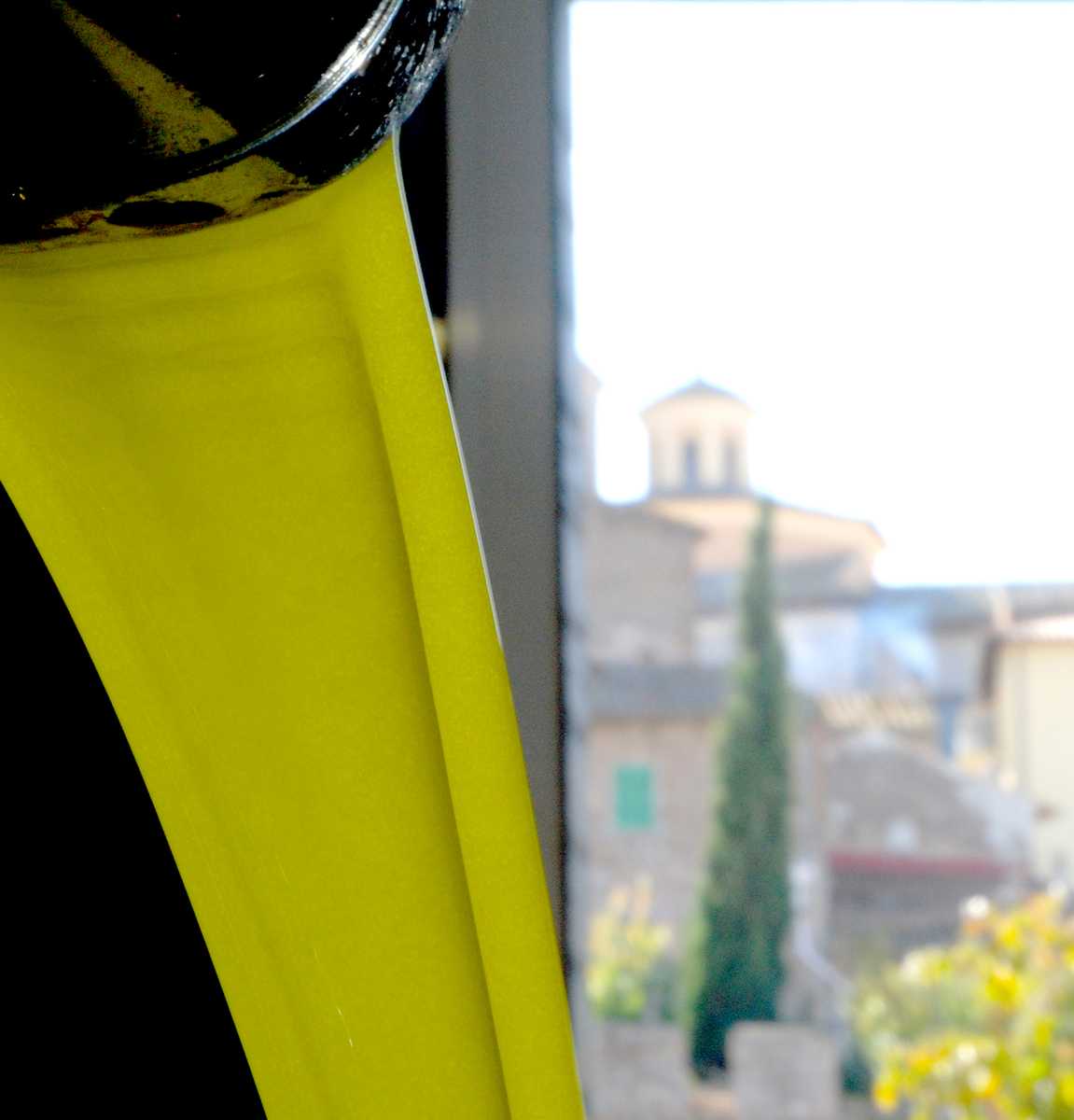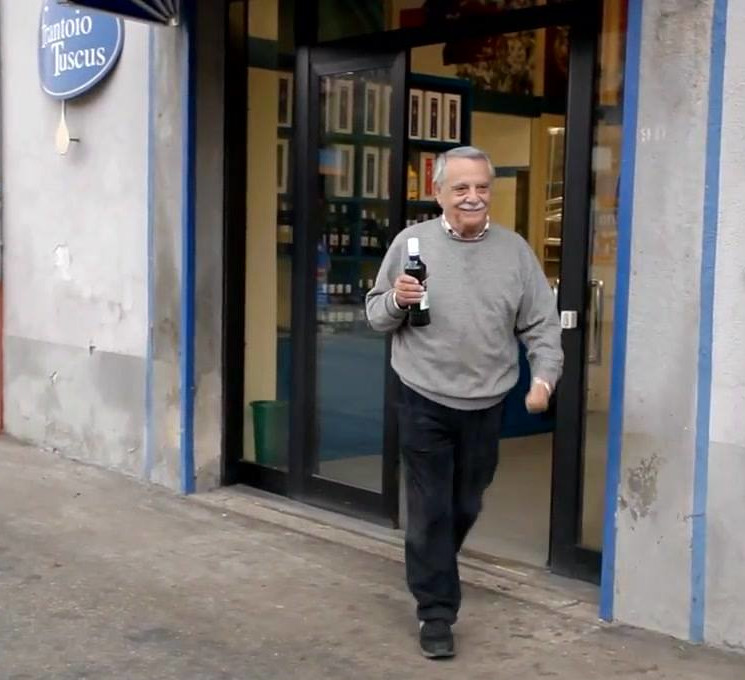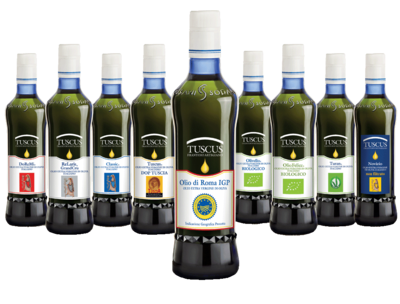1. Oil from olives.
As we know, olive oil has very ancient origins: archaeological research allowed us to find traces of ancient Etruscan and Roman mills where olives were pressed. Roman writers such as Columella in the monumental "De re rustica" written 2000 years ago show an amazing olive oil knowledge, its characteristics and its use for food and therapeutic purposes, often as a vehicle to dispense other substances to patients.

In the Middle Ages the situation changes: other peoples with different food traditions arrive in Italy, feudal lords often establish a tax on olives milling, the are few mills because they need a minimum capital investment, very difficult in a depressed barter-based economy. Olive oil is mostly used in southern regions, where olive trees give more fruits: the prevailing food fats, especially in the northern regions, where cattle and pigs are more widespread, they become those of animal origin (butter, lard, lard) that cost less and can be produced without special equipment. The oil regains importance in the Renaissance, with the end of the feudal regime and the birth of free municipality. Coin starts to circulate, increases the life level and consumption too. Investing in the construction of new oil mills, the oil craftsman (the master oil maker) who sells his product to merchants or directly to consumers is born. In the following centuries oil consumption and its trade grew. In the twentieth century, industrial development also touches olive oil: people are beginning to appreciate the fact that it is not subject to rapid deterioration like animal fats, it is more easily transportable in large barrels, and has a palatable taste that does not overlap with that of the foodstuffs to which it accompanies in the kitchen.

Next to the craftsman there is now also the oil industrialist, who does not disdain the use of the possibilities offered by new technologies and chemistry to try to achieve greater profits. In the 1930s, the industry found a way to use pomace, until then a by-product of olive pressing, to obtain oil, sold as olive oil, through a chemical process using substances such as soda caustic. A period of confusion begins: the oil obtained from the milling of the olives is the one subject to chemical tricks, everything is marketed as "olive oil". At the center of attention there is now the oil produced by industrial oil mills, while the ancient artisan mills seem destined for progressive extinction. The entry of the "Encyclopedia Treccani" in a volume published in 1935 gives an in-depth account of the new machines for obtaining olive oil and of the (then) new procedures for obtaining oil from the pomace: not a word is dedicated to the artisan oil mill except with reference to a very ancient past.
The war events, the difficulty in distributing the oil produced by the industries, the scarce availability of the olives which, if not pressed quickly risk becoming scarcely usable, give new life to the nearby oil mills: the oil becomes a precious asset again.
In the 1950s, the olive oil industry resumed life and with it the processes of esterification of the pomace and the most sophisticated frauds, up to the production of a substance passed off as oil and obtained starting from the hooves of a horse.
Finally in 1960 a law intervenes that distinguishes the extra virgin olive oil, produced directly from olives, from other types of oil, obtained with the help of chemistry.
It is a divarication destined to grow with time, also because the artifices to give the oil those characteristics that allow it to be qualified, according to the regulations in force, as extra virgin olive oils, become more and more complex and sophisticated, thus deceiving the consumer. To defend the tradition and with it the authenticity of the product remain, alongside the industrialists who shun frauds, the artisans who, also due to the size of the company, do not use those tricks for which they do not even have the necessary equipment.
The birth of the European Economic Community marks an important point in the production and marketing of olive oil: the Community directives, which establish the characteristics of the products, including oil, in order to ensure conditions of equality between producers in different countries of the community, impose a series of rules, implemented in national legislation. The legislation regarding oil refers to its chemical-physical characteristics, smell, taste, packaging label, never the production process: what matters, and could not happen otherwise, given the aims pursued, is that the oil and its label have characteristics that guarantee free competition between producers in the borders of the Community.

This should serve to eliminate fraud, but often this is not the case: technology and chemistry run faster than national and EU laws. The freedom to make the most appropriate production choices to face the competition becomes for the oil, as for many other products, the picklock that unhinges the rules, in a continuous chase between the search for leaks in the network and their closure, always unfortunately late . Even the implementation of EEC regulation 1974/2006, with the establishment of the national quality system for extra virgin olive oil, moves - and could not be given the aforementioned premises - in the line of product qualification: the gray space of the product continues to remain process qualification, a problem that today seems to be able to find a solution with specific production regulations accompanied by ethical legislation that provides solid guarantees for the consumer. Certainly considerable progress has been made in this direction: the very recent law being published in the Official Journal. The quality and transparency of the extra virgin olive oil supply chain is the last step in this long march. But once again it concerns the product: it is therefore necessary to fill the last void - the production process - to close the circle of protection. At least as far as the oil produced by the artisan companies is concerned, the instruments already exist, as will be seen below. This should serve to eliminate fraud, but this is not the case: technology and chemistry run faster than the EU and EU laws. The unanswered, the unleashed. . Even the implementation of EEC regulation 1974/2006, with the establishment of the national quality system for extra virgin olive oil, moves - and could not be given the aforementioned premises - remain process qualification, a problem that is based on ethical legislation that provides solid guarantees for the consumer. Certainly considerable progress has been made in this direction: Quality and transparency of the extra virgin olive oil supply chain is the last step in this long march. But once again it concerns the product:
2. Oil and the craftsman
The artisan according to the etymology of the word (from the Latin ars, art) is the artist: a person who processes raw materials based on rules that belong to tradition and culture in a material sense of the territory in which he lives, interprets those rules based on his sensitivity, his talent, his personal ability, and finally he reaches a result, a product of his creativity that, sold to others, will get him what is necessary to live.
In our country the golden age of craftsmanship is the Middle Ages.
The artisans keep the workshop: the master, the master as they used to say in those days, in the shop has a host of young apprentices who work under his direction, they learn to paint as well as to carve wood or marble, to weave wool or processing jewels, to grind the grain in the mill to obtain flour or olives to obtain oil. In the thirteenth century the guilds in which the artisans gathered were as many as 21 of the major arts and 14 of the minor ones: among these, the art of the olaioli, that is, those who smashed olives in the mill, with large stone wheels , to extract the oil. The guild became one of the most powerful of the Medici Florence: in fact, pizzicaroli and then even the woodcock were added to it; a kind of food holding company from which millers and bakers remain. It is no wonder that even today there are shops selling only bread and other only cheeses and cold cuts: it is a tradition that was born nine centuries ago and that the supermarkets are now putting in crisis. Characteristic of the guild and of every medieval corporation was to have precise rules of production which were both a production disciplinary and an ethical code: "those who did not respect those rules were expelled from the Guild": in practice he could no longer carry out his activity.
Years passed, centuries passed: the guilds dissolved, the artisans continued their activity observing the ancient rules learned in the shops; even though there was no longer an authority that imposed its respect. Some trades declined because the need for this or that specific product failed; it happened, for example, for the armor-makers who made armor or for the correggianis specialized in the manufacture of harness for horses. Others, and in particular those related to the elementary needs of the person - eating, dressing, caring if sick - remained alive and changed the reference models. The apothecaries, for example, are the ancestors of the current pharmacists. This is also what happened to the oliandoli: the mills, under the watchful eyes of the oil masters, continued to grind the olives. The oil obtained was then sold or delivered to the owner of the olives against payment for the service rendered with the milling. The rules changed little: those of tradition remained and the oil master continued, half entrepreneur and half artist, to decide on the mixtures of cultivars to be used, on the decantation times of the oil, on the suitability of the degree of ripeness of the olives to obtain a good oil.
No oil mill was the same as another, yesterday as today: the sense of artisan production was precisely - and still is today - in the diversification of aromas, of flavors, just as the interpretation was, so to speak, different of the rules by the oil master, and the mixture of the cultivars used, to be set in turn in relation to the nature of the soil in which the olive tree grows, to the climatic conditions of the area, to the farmer's choice in favor of one or of the other cultivar. As consumption increased, the oil mills became increasingly important in the agricultural economy at a crucial point between olive producers and oil consumers: not infrequently the great landowners worried about having an oil mill among their properties, for to make large profits, obtained above all by bringing forward the price of the harvest to the olive producers in exchange for the lowest price.

3. Craft and industry.
In the 1800s, when the industrialization process began painstakingly in Italy, the nascent industry immediately strained to relegate the handicraft into narrow borders: mass production allowed for a lower price than the product which tended to impose itself on the artisan very often at the expense of of quality. Industrial wages, although not high, were always better than those of artisan apprentices: the young suffered the charm of the factory and no longer that of the artisan workshop. It was obviously impossible to stop the course of history and in truth no one pretended to do it: sometimes the artisans gave a broader scope to their activity, they chose the path of serial production and transformed the shop into a small industry that sometimes over time gradually assumed more and more. size. Others remained faithful to the ancient craft, to the production made of inspiration and manual skill, even though they also used machines, so that at least in part the fatigue of man and animals could at least partially be avoided, with steam operation and direct current. example the donkey - which had been used up to that time. The olive oil master continued his work: the mill of the mill did not stop even in the most difficult periods of the history of our country, the young did not disdain to work in the mills to learn an art that had survived over the centuries and that all allowed us to foresee that had long life.
The oil industry did not disdain the use, starting in the 1930s, of techniques such as the esterification of fats, which had nothing to do with the oil tradition but which allowed them to produce oil at low prices. The defense of craftsmanship in this and in all the fields in which the artisans worked for centuries became a necessary goal to pursue for the public power: it was a matter of guaranteeing the survival of the artisan work and thus safeguarding an aspect of history, of culture and the tradition of our country.
The orientation of the State in this sense emerged already in the Fascist period with the birth of the various corporations including that of craftsmanship, which implicitly meant recognizing a specificity of that activity with respect to industrial activity, and small industry in particular. After World War II, the rapid industrial development that seemed to have no limits in all fields, risked wiping out Italian craftsmanship without too much distinction for the activity carried out: the industrial product seemed to have conquered - or about to conquer - all the space of the market.
Once again the legislator intervened: with the law n. 860 of 25 July 1956 the craft enterprise was identified for the first time, distinct from the small industry, and a discipline of craft and training activities was established at the school - workshops, thus defined on the traces of the ancient medieval art shops. In this way the way was opened for public support, even if indirect, of craft activities, implicitly guaranteeing the continuation of their presence on the market, even if very limited and only in the traditional sectors of the activity itself.
The law of 9 August 1958 n. 43, subsequently modified with the law 20 May 1997 n. 133 and with the art. 13 of the connected to the financial law for the year 2000, has continued for the same road, even considering the happened constitution of the Regions with ordinary statute and of their concurrent legislative and administrative competence in matter of handicraft.
The pivot on which the current legislation revolves is the definition of artisan enterprise, and the characteristics that it must have, leaving the Regions to issue their own laws to further regulate the matter (for example the apprenticeship, the measures to enhance the artisan work, indirect support through exhibitions, fairs and markets aimed at enhancing the artisan product).
4. Oil miller and handicraft oil.
There is no legal definition of a mill: in common parlance it is the place where they are pressed, that is to say crushed olives to obtain oil. At one time the pressing was done with millstones, large wheels made by a donkey or a bandaged mule and attached to a wooden pole. Today the reality is very different: the machines are increasingly sophisticated, electricity is used and no longer the animal, the master of oil has a series of easy-to-use tools to obtain the desired result in terms of taste, density and color of the oil, always without the addition of additives or the use of chemical processes.
Also with regard to oil, the artisan product is a competitor to the industrial one.
The competitiveness of the product does not take place with reference to the price but to the characteristics of the product itself, specifically linked to the choices of the manufacturer, and to its specific characteristics, in addition of course to those required by Italian standards and by the European community.
The difference between an oil and the other is not easily perceptible by the consumer based on the indications contained on the label, very summary, even if the indication of production and bottling by an artisan company should - but not they always are - to be a sufficient indicator to guide the choice.
The qualitative indications, which lead to the emergence of the artisan product, for oil as for other products, seem increasingly destined to fill a void, in the interest of the consumer, who should have direct information of being or not, oil who is about to buy, produce and bottle from a mill or other different companies. Only when this is clearly possible will the indispensable condition be fulfilled for the permanence on the market of the artisan oil companies, an essential condition among other things so that the olives produced in Italy will continue to have a profitable price for the farmers, not crushed by the threat of supply oil in other countries and placed on the national market, perhaps after a skilful "retouching".
It is a danger that should be avoided: Italy without the olive trees and without the mills, which are the necessary completion, would be another country, certainly not better (and not only in terms of landscape) than the current one.
5. High quality and handicraft oil.
The new rules relating to the high quality of olive oil establish, as has been mentioned, product parameters on which quality is measured. Moreover, even after the enactment of the new rules in the extra-virgin olive oil supply chain, there is a leap: from olives to oil obtained from them without any regard to production processes that can be very different, for example, to the mixing of different cultivars, which falls within the full discretion of those who fringe olives. The crux of the matter is all in the possibility of avoiding that leap and this is not based on juridical norms that could never be exhaustive, but through a collaboration of the producers. It is almost obvious that this collaboration could hardly be offered by industry, given the serial character of its production. The case of craft companies is different, as they act on smaller quantities and can guarantee the complete articulation of the production process of their product and its compliance with the rules of a freely constituted consortium.
A possibility in this sense seems, after all, textually offered by art. 6, No. 9 of the enacting decree establishing the national quality system, where it is envisaged that the "operators" (among which are undoubtedly the artisan mills) to "favor the system" can "constitute a consortium recognized by the Ministry with a specific decree".
Since a consortium cannot fail to understand the aim pursued, with the limitation in this case of favoring the high quality system, it seems completely normal that the purpose could be to guarantee the consumer high quality also with regard to the production process, compliant with the production specification adopted by the consortium itself. In this way, the gap between olives would be filled in favor of the consumer and the quality of the oil and produced, and limited to the minimum, the possibilities, though always to be taken into account, of fraudulent sophistication.
One or more consortia of artisan companies that fry olives and sell the oil produced, with the mention of the consortium itself and of the regulations to which the companies comply, therefore, seems to be the logical solution that arises from the new discipline: if you go to the contrary , once again the protection of product quality (and with it the consumer) would risk remaining in the limbo of good intentions.

